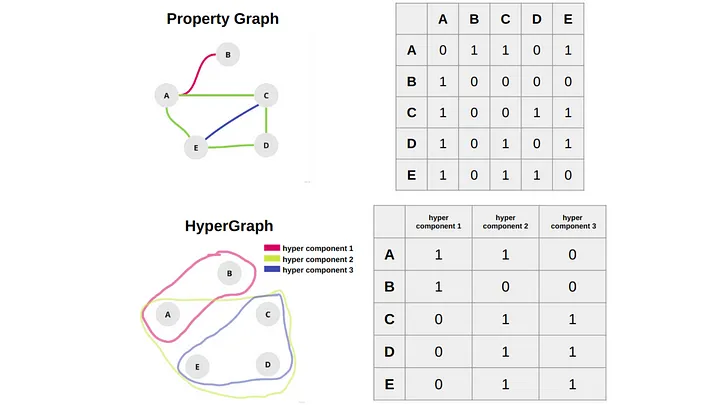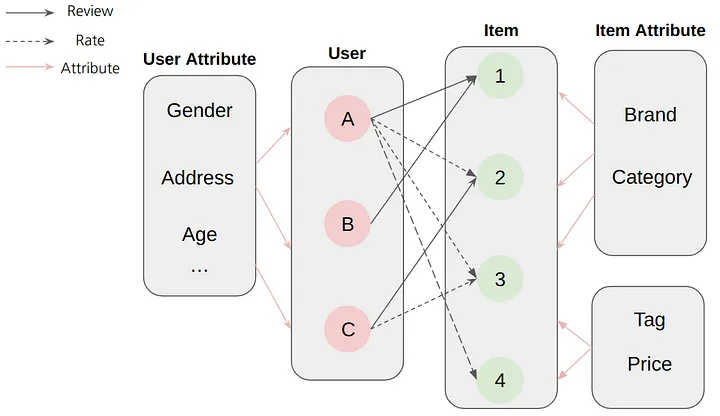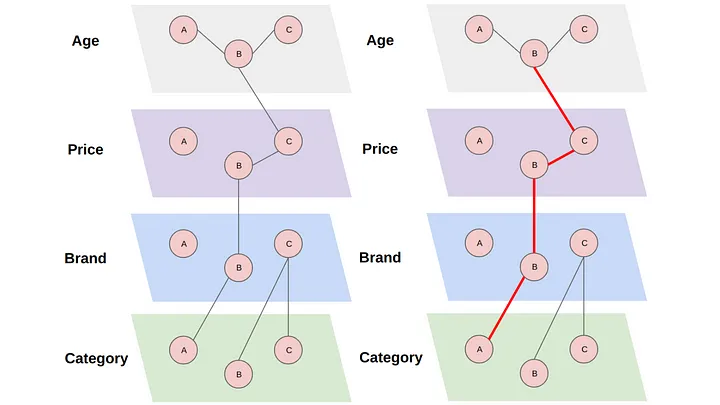
Empowering Recommendation Engines with Advanced Algorithms for Personalized Suggestions

In today's data-driven digital landscape, personalized recommendations have become essential to user experiences across various platforms. Businesses are seeking ways to stand out and provide tailored suggestions that resonate with their customers. That is where recommendation engines equipped with advanced algorithms come into play. This article will explore the mechanics behind Hybrid Graphs to help you and your business understand the vital data analysis, management, and visualization process.
What is a Hybrid Graph?
A Hybrid Graph is an analysis technique that combines the advantages of property graphs and hypergraphs. A Property Graph is a graph that labels the characteristics of nodes and edges, making it easy to spontaneously understand the relationship between objects.
A hypergraph is a graph consisting of nodes and a hyper-edge, which makes it easy to identify common properties because common properties between nodes can be represented by tying them together into a hyper-edge. By combining the two advantages, you can intuitively analyze the relationship between the data to derive associations and analyze common properties in relationships to easily use them to define clusters.
AGEDB is a product that use graph query modeling along with the existing relational model simultaneously. AGEDB is a solution to query and explore RDB with its SQL syntax support.

Figure 1. shows the difference between the graph and the hypergraph. Property graph shows connections between nodes as 0, 1, whereas hypergraph shows common properties through elements called hyperedge 1, 2, and 3, and matrices show hyperedge presence or absence as 0, 1. As you can see, A and B are bound by a common property called Hyper Edge 1, and A, C, D, and E are bound by Hyperedge 2.
The property graph shows a pair of connected nodes representing a one-to-one relationship, whilst, the hypergraph shows a one-to-many relationship through an element called hyperedge and represents data relationships in an integrated way. Each graph has its own advantages and disadvantages and the best use case depending on its serving purpose. So the next question naturally is, when are the good times to use each graph? That is where the Hybrid Graph comes in.
Hybrid graph utilization value
-
1. Data analysis: Hybrid graphs are useful when analyzing related data as they represent and analyze complex relationships between data. The hybrid graphs enable to identify patterns, correlations, and trends that cannot be seen without a visual representation of the data. In social networks, graphs express relationships among individuals and provide insights into individual behavior and network structure. In marketing situations, hypergraphs help better understand customer behavior by analyzing common relationships among complex factors like products and customers.
-
2. Communication: The ultimate goal of data analysis is to persuade others through insights derived from data and hence the hybrid graphs. In persuading the matter with depth understanding of the phenomenon, property graphs identify causes and effects through nodes and edges. If causes and effects are visualized through property graphs, the abstract concepts must also be represented through graphs. As a result, the property graph increases understanding of the phenomenon and enhances communication internally and externally.
-
3. Data Management Efficiency: Based on hyper-components that contain common characteristics, you can exclude information unnecessary in managing data. It is particularly beneficial for metadata management, i.e., classifying and organizing data based on rules in large amounts of data.
In summary, using a property graph to express relationships between individuals and a hypergraph to express common relationships can lead to different values depending on the situationship respectively for individual and group analysis. Let's then take a look at the implementation of the graph concepts explained above in real-life situations.
Example of Hybrid Graph Application
Below is an example of how hybrid graph analysis is performed on data and derived communication value.

Imagine we have a graph where users, items (Eg., Clothes and accessories), and brands as nodes. The edges show the connections between users and items through ratings and the links between items and brands.
This graph structure allows us to examine how users rate specific items and how those items are associated with particular brands. By analyzing this data, we can gain insights into customer preferences, famous brands, and the overall sentiment toward different items. .
Let's say we have fashion review data from a shopping mall. In phenomenon analysis, we design the graph structure as shown in Figure 2. above. The node consists of three types: user, item, and brand. The edge consists of the ratings by a user on an item and the relationship between the manufacturing brand.

Figure 3. shows the property graph, representation of items, and user rating behavior. Through property graphs, you can find two users with the same interaction on a particular item. These allow you to discover new relationships through common attributes that do not directly have a history of relationships between users but indirectly have the same interaction with items.
The designed graph modeling represents the use-item-brand nodes and relationships as below. The node represents the users, and the outlined hyperedges represent the brand with the item's characteristics. These allow us to create a meta cluster for nodes grouped based on a brand.

Now, let's look at meta clusters as users with similar brand preferences; we can analyze trends based on these clusters and analyze and evaluate strategies such as brand-specific marketing and product planning strategies. If the above analysis was performed only through a property graph, it would only give insights into the relationship between the user and the item. The hypergraph, however, would enable the analysis with hyperedges and allow for a further search for the property (brand) of the item.
Hypergraphs make complex relationships more visible.
Multiple common attributes and relationships help us further understand the benefits of hypergraphs. How would it change if we convert a complex property graph with a mass number of properties and relationships to a hypergraph? If the user-item node interaction expresses one kind of relationship, the phenomenon can be analyzed clearly and concisely, as shown in Figure 3. However, it is a different story if you want to see more types of relationships and the characteristics of users and items. If you analyze various relationships and characteristics together, the disadvantage is that it becomes more complicated because you first recognize the interaction between the user and the item, and you have to analyze them through multiple nodes and relationships by looking for additional characteristics.


The best way to approach this analysis is to apply a hypergraph. The img above describes the transition from the property graph to the hypergraph. Unlike traditional property graphs, hyper-edge represents the behaviors of users A and C, who have left the same review on a common item. These allow us to discover relationship-based meta-users that would have been difficult to observe in existing property graphs. This meta-data management also helps to add and remove user and item characteristics that meta-users have and transform them into hyper-edge and process meta-to-purpose. Furthermore, hypergraphs can visualize multiple overlapping hyperedges in layers, and the visualization results are as follows.

Figure 7. represents the hyper-edges in Figure 6. divided in multi-layer. Nodes represent users as before, and the added layers represent common relationships or common characteristics. This process helps to analyze the phenomenon layer by layer and discover new insights. For example, among A, B, and C customers of similar ages, B and C can link up their purchases of items of similar pricings or approach and analyze them in many ways, such as A and B, who purchased the same category from different brands. In addition to using each layer to derive insights, the multi-layer advantage is that you can link all four layers of age-price brand categories to see the chain reaction to the phenomenon at a glance.
As discussed in this article, it is recommended to select and/or combine the use of property and hyper graphs depending on the relational nature of your data.
A hybrid Graph allows one to analyze phenomena concisely based on relationships and characteristics between individuals or groups. The Hybrid Graph encourages collaboration with others as they visualize abstract causal relationships in detail. Further, Hybrid Graph enables the analysis of chains through hyper-edge division into layers.
Deriving insights from relationships and linking them to business in a modern society where connections between people or objects are fused can be a hustle. From SNS to blockchain and IoT, the layers of relationships and networks are used in many situations today, and it isn't easy to find a way to fully utilize obtained data. AGEDB is your solution for all data analysis, management, and visualization.
Interested in learning more about bringing your data into hybrid graph? Contact us today to get in touch with our graph expert and learn more!